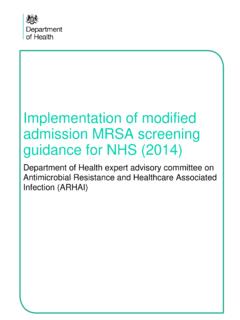Transcription of Early years - GOV.UK
1 The report of Her Majesty's Chief Inspector of Education, Children's Services and Skills 2015. Early years Figure 1: Number of providers and inspections completed between 1 November 2013 to 31 March 2015. Provider type 49,385 13,390. inspections Inspections Providers of childcare on childminders domestic premises Early years 201 78 Register 28,154. Providers of 12,272. childcare on inspections non domestic premises 1,909 351. single centres inspections Inspections of Children's provision for centres children aged 0 5. Independent schools 526 210. group centres inspections 253 45. Secondary schools 115 18 15,597 2,222. primary inspections schools Pupil referral units Schools with 6 4 Early years Special schools 411 109. nursery 521 85 schools inspections 1. Inspections of Early years providers not on the Early years Register as at 31 March 2015 are not shown above. 2. Inspections are included where published by 30 April 2015.
2 3. Inspections are based on provider type as at 31 March 2015. 4. Early years judgements are made at inspections of maintained schools and independent schools with Early years provision. The judgement was introduced on 1 September 2014. 2. Contents Foreword 4. Executive summary 6. About Early years 7. The provision of Early education 8. Comparing quality and choosing a provider 13. Getting ready for school 19. Collaborating on improvement 30. Key statistics 34. 3. Foreword In April 2014, we published our first report on the Early years sector a report we believed brought a fresh look at the potential of this sector and the challenges it Now, with the publication of our second report, it is worth reflecting on the major changes that continue to unfold. For many years , Early education has received a considerably lower profile in the media and in political debate than education for school-age children.
3 However, this is changing. The recent general election campaign was evidence of this shift in focus. Provision for the youngest children was a major policy battleground and resulted in a key pledge in most party manifestos. Since the election, childcare has retained its priority in the national debate and featured in the first Queen's Speech. The status of Early years has been further reinforced by the creation of a new ministerial Childcare Taskforce. As a result of these changes, the sector is poised to receive a major injection of public money. To date, the focus of the debate has rested heavily on the cost of childcare and the burden this represents for many working families. The extent to which this focus broadens to address a more rounded view of the priorities of parents remains to be seen. While many parents may be concerned about the cost of childcare, they are also concerned that their child is in a caring environment where they are developing well.
4 Last year, we challenged the view that the Early years sector is predominantly about childcare rather than The parents who teach, whether they realise they are doing it or not, give their children the greatest advantages from the very start. Teaching for small children is not blackboards and desks, it is counting bricks when building a tower, learning nursery rhymes and familiar songs, or gently coaching a child to put their own arms into their coat. The most successful Early years providers, whoever they are, are focused on helping children to learn.'. Sector report 2015: Early years 1. Early years annual report, Ofsted, April 2014; Early years annual report 201213. 4. Ofsted's Early years Annual Report, July 2015. Over the past year, we have worked proactively to develop a partnership with the sector. The feedback from this work is that, increasingly, professionals now embrace the notion of teaching the very youngest children and are more willing to see themselves as teachers.
5 In his speech accompanying our last report, Her Majesty's Chief Inspector (HMCI) argued strongly for a clearer and more ambitious role for schools in coordinating, supporting and delivering high quality Early years for the most disadvantaged children. Last year, the government introduced legislation to reduce the burdens on schools that take two-year-olds. This legislation: removes the requirement for schools to register separately with Ofsted if they take two-year-olds will allow childminders to provide care on school premises under their childminding registration will allow childcare providers to register once for several premises. The government has also brought in changes to the admissions code to enable schools to prioritise children eligible for the pupil premium and Early years pupil premium in admissions. In the period since our last report, Ofsted has also made progress.
6 From September 2014, we re-introduced a separate Early years judgement for schools with Nursery and Reception provision. From September 2015, we will go further. With the introduction of the common inspection framework,2 all Early years provision before Year 1, whether in the public, private or voluntary sector, will be judged using the same inspection framework. Nick Hudson National Director, Early Education 2. Changes to inspection from September 2015, Ofsted, June 2015; 5. Executive summary 1. When parents now research what is on offer for their children in their area, they will be looking at Early education that has never been stronger. Parents can choose between private, voluntary, independent and public nursery and pre school provision or a home-based setting with a childminder. More than 80% of each of these types of provision is now good or outstanding. 2. Early years practitioners increasingly appreciate that they are there to teach children, not just provide childcare.
7 The Early years Foundation Stage has been successful in focusing professionals in the sector on the importance of learning. Children have benefited from this and there has been a big jump in the proportion of children reaching a good level of development by the end of their Reception year. 3. At a national level, Early years is enjoying a political profile that is unprecedented. Issues relating to the cost, capacity, accessibility and quality of Early education and childcare have been making national headlines. The major commitment to increasing the 15 hours of funded Early education for three- and four-year-olds from working families has featured in the Queen's Speech and the Prime Minister's Early speeches. The challenge will be in implementation. The volume of Early education places has remained relatively static over the past few years , but the child population has jumped.
8 If demand grows in response to the government's increased funding, there are likely to be areas where capacity comes under pressure. 4. While it is encouraging that outcomes for children from disadvantaged backgrounds are rising in line with the peers, there is no sign of the gap narrowing in any substantial way. Early education can make a fundamental difference to life chances, but only if the child receives high quality Early education at a young enough age. Around 113,000 two-year-olds were eligible for 15 hours of free Early education but did not take up their place. This represents 42% of all eligible children. Health visitors hold the key to promoting take-up from age two to families; the universal one-year check on children is the opportunity to do so. With the transfer of public health to local authorities in September 2015, many important levers to deliver change in the Early years from this point forward will sit with local leaders.
9 5. One of the reasons some children start school at a disadvantage is because the school does not have a good enough relationship with its feeder nurseries, pre-schools or childminders to make sure each child has a smooth transition Sector report 2015: Early years into school. Schools must do more to support transition and the perverse incentives that work against this must be removed. Problems with transition can also be avoided if children attend school nurseries where they can progress directly to Reception without having to move provider. Fewer than 5,000 schools take two-year-olds, but, of those that do, the two-year-olds attending are disproportionately from better off 3. Figure does not include maintained nursery or independent schools 6. About Early years Early education is crucial But Early education is only part of 6. Children's Early years are the time between birth the story and the 31 August following their fifth birthday.
10 10. In this report, we consider what our inspections This is a time of dramatic growth and development: have told us about the quality of Early education. a child's brain doubles in size in the first year and We will look at examples from providers that show by age three it will have reached 80% of its adult what works well to help children learn. volume. A child is creating synapses at a very fast rate. At age two or three, the brain has up to twice 11. However, there are limits to what we can know as many synapses than in Because the through inspection. Early education that is Early years are a time when children are learning provided outside the home is only one small part rapidly, how well they are taught, whether that is at of what happens in the lives of children from home or outside of the home, is very important. birth to starting school. Unlike in schools, which every child must attend, how children experience 7.














